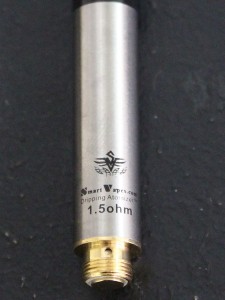One this page, we will go over all of the different types of atomizers to put on top of your devices.
In this section, we will talk about the atomizers that are meant to be as is (I.E. non-rebuildables)
Clearomizers
Clearomizers are fairly simple. There is a base with a connection, either a 510 or ego threaded cone, a head that screws into that base{the “head” holds the wick(s) and coil(s)} and a tank that the base screws onto. Some of the clearo’s use a top coild design, which is the same except the head screws into the tank itself, and you screw on a top portion to seal it all in.
There are tons of styles, brands and iterations. Popular brands include Aspire, Kanger, and Innokin. There are new ones with airflow control; this is a cool addition to be able to increase to decrease your vapor/suction.
Cartomizers
A cartomizer is a metal tube with a wick and coil in the bottom of the tube. The tube is filled with polyfill (a synthetic material used to hold the e-liquid), and has a connection on the bottom to screw the carto onto your device. They usually come in 1.8, 2.0, and 2.5 ohm increments.
A Carto Tank is a very simple addition to cartomizers that makes it able to hold more juice. You take a cartomizer, punch a hole near the bottom of the tube on both sides, and a tank that fits around the outside. It is held in by either an o-ring at the top and bottom of the tank, or the cartomizer is screwed into the tank. There are many variations and styles of carto tanks but they all have the same purpose, to add more capacity to your e-liquid storage before it gets vaped.
One last option is something called at Dripping Atty.

These are nifty little atomizers. You have a metal tube with a wick and coil in the bottom, covered by a mesh bridge that catches juice and delivers it to the coil. Another variation is the “bridgeless” style where there is no bridge; instead, there is mesh surrounding the coil itself to bring the liquid to the coil.
Now, on to the atomizers that are rebuildable.
The concept is basic, you have a base with a 510 connection on the bottom, and two or more posts on top. You connect your coil to a positive and a negative post, no matter how many posts you have (more negative posts you have, the more coils you can mount on the atomizer), and that’s it!
Popular kinds include the Igo family (Igo-L/S/F/W), the inexpensive option; The Patriot, your mid option; and the Origen, your high end option. These are just popular atomizers and are by no means “the best or only option,” they are only just examples.
Next up on the list are RBA’s.
This term literally means Rebuildable Atomizer, but it commonly used to refer to atomizers with a tank on the bottom of the base with the positive and negative post(s).
The first and most popular style is called a “Genesis Style RBA.” This means you have your base, and your positive and negative post(s); then you have a hold on the deck that you use to put your wick through (most commonly mesh or stainless steel cable) to get the juice from the tank below, to the deck uptop, through Capillary Action. There is also a hold that usually has a rubber plug in it, that is used as a fillhole for the tank itself (Recommended to use a U-Can or blunt tip needle to fill). Most common and inexpensive option is the RSST.
The second and most recent innovation in atomizers with tanks is the Kayfun style. These are probably one of the more complicated designs ont eh market for atomizers right now. You have your base, then a chamber on top with two grooves in the base to lay your wicking material, then a cap that screws onto your base and over the coil and posts, then a tank that screws on over the chamber, and finally a top cap to hold it all together. The chamber in the middle that holds the coil and wick is a vacuum. Every time you puff in vapor, it pulls more juice into the center chamber to be vaporized.
Drip Tips
A quick side note on drip tips. There are many different kinds and they come in a variety of shapes and sizes. There is a standard drip tip size, 501, that is generally used. Problem is, there’s not “standard size,” just a general size. Some may fit in some devices but be super loose in others.
You have short ones, long ones, curved ones, and straight ones. Wide bore drip tips help increase airflow and let you drip through the actual drip tip (as they were initially used for).
